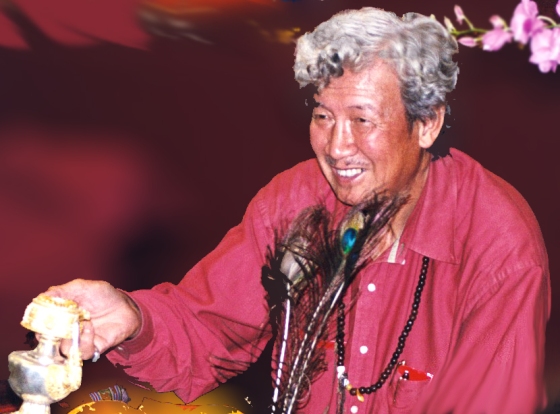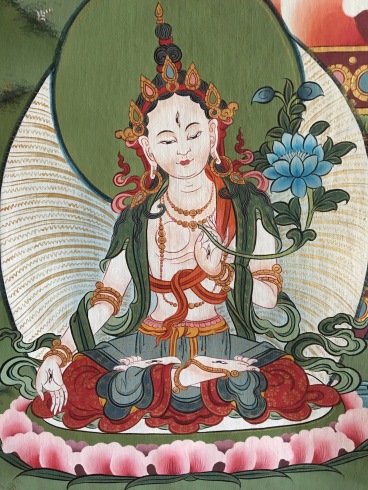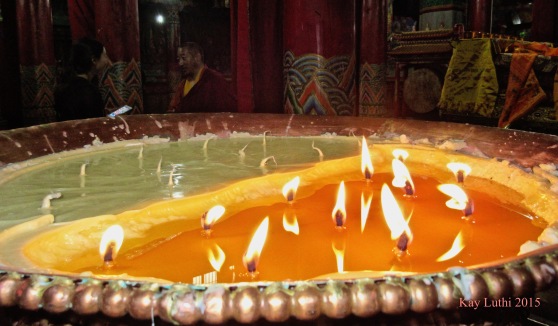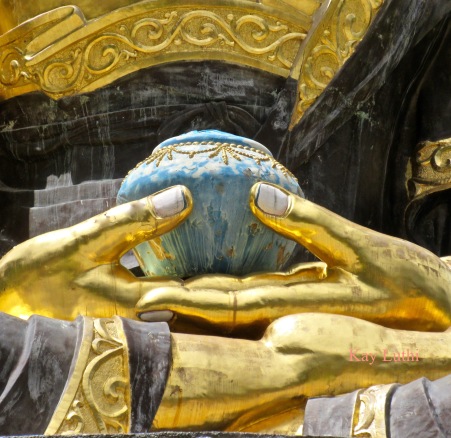
Master Zi Sheng Wang
When I began teaching tai chi 30 years ago it was often the case that a few of my new students were physically unable to participate which was extremely disappointing for them and sad for me to see. I felt there must be a system where all levels of ability have an equal opportunity to benefit. With the goal of benefiting the greatest number of people, I decided change my focus to the healing arts.
After three years of searching for a qigong master, I had the extreme good fortune to meet my Tibetan Buddhist Qigong(1) teacher, Vajrayana(2) Master Zi Sheng Wang. During our first meeting in 1998, I had no idea how rare and precious Master Wang’s skills and abilities were. But I did comprehend Master Wang’s innate uniqueness. The qigong movements taught by Master Wang were very gentle, deceptively simple, produced lots of energy and were deeply meditative and relaxing. The energy (qi) I felt during practice far exceeded anything I had experienced before.
By “energy,” I refer to my own “energy field” and its interaction with energy of the earth and the cosmos. From my first encounter with my teacher, my understanding of qi and qigong master took a quantum leap forward. I had found a high level Tibetan Buddhist qigong master whose kung fu (ability) was in a class of its own. My search for a qigong master had ended.
All qigong forms should accomplish three basic things:
- gather universal qi
- balance one’s qi (yin and yang energy)
- release unhealthy qi
When the channels clear healing can occur on a physical, mental or spiritual level. In this respect, Tibetan Buddhist Qigong distinguishes itself by the rapid progress students make; i.e., when practicing Tibetan Qigong the ability to process qi is greatly enhanced.
“Everyone wants to be happy and healthy. We all have great untapped potential for self-healing. Our bodies are infinitely wise and want to be well.Our hearts want to express the boundless compassion and joy that is our true identity. Tibetan Qigong offers us a way to bring forth this inborn wisdom and ability.”
~Master Zi Sheng Wang
While teaching my first Tibetan Qigong class, I was amazed at the response from my students. At the start of class one man appeared too weak to participate. His complexion was ashen, he was hunched over and walked with a limp, but after only four weeks this man looked like a completely different person. His complexion had changed from ashen to radiant; his posture was good and he walked without a limp. Another student, a longtime qigong practitioner, generally came to class with a stoic expression on his face but soon began to arrive with an ear-to-ear grin. For years he had tried to gain weight and was finally able to do so. He also mentioned that relationships with his medical colleagues had improved. A third student who had strained relations with her husband sat during each class instead of standing because the energy was so intense for her. Several weeks after the class ended she told me she and her husband were having a wonderful time touring the country together in their RV.
Later I would volunteer at Collabria Adult Day Care (ADC) in Napa, CA, teaching Tibetan Qigong to adults with cognitive and physical disabilities. Most were in wheelchairs. My students’ limitations never posed an obstacle to benefiting from Tibetan Qigong because several of the forms Master Wang brought to the West can be done standing, sitting or lying down. Collabria ADC’s occupational therapist and physical therapist were very pleased how Tibetan Qigong improved the physical and mental states of their clients. Physical and mental health transformations are common for students who attend Master Wang’s energy sessions(3) or classes, but to see such transformations in my own students was completely unexpected.

Photo from Lingtrul Rinpoche
My students benefit because my teacher belongs to a very powerful, unbroken lineage, the Tibetan Buddhist Nyingma tradition which is over 1,200 years old. Students of Tibetan Buddhist Qigong receive healing energy from the lineage of Master Wang and his teacher, renowned Dzogchen(4) Master Khenpo Munsel Rinpoche(5). Any success I have as a qigong instructor is due entirely to my teacher and to our lineage.
Why do Tibetan qigong students make such rapid progress? Here is Master Wang’s explanation:
“In China those who have an understanding of different qigong traditions know that Tibetan Qigong is the highest level of energetic practice. These knowledgeable practitioners try to learn at least one Tibetan Qigong form to enhance the qigong forms that they already know. Why is Tibetan Qigong considered the foremost qigong? Rainbow Body. In Tibet, Rainbow Body is considered the highest form of energetic practice. Hundreds of thousands of high level Nyingma lamas have achieved Rainbow Body, although very few have been recorded in modern times.

“What is Rainbow Body? Some lamas who have spent a lifetime of diligent practice, at the time of their passing transcend the death process by transforming the elements of their body into bright light and heat; rainbows often appear in the sky. These lamas have no fear of leaving this world and do so with joy and happiness. Complete Rainbow Body is the highest form and occurs when nothing remains of the body. The second highest form of Rainbow Body is when only the hair and nails remain. Vajra Body occurs when the body shrinks to the size of a forearm and is considered the third level of Rainbow Body. Only the lama’s closest disciples are invited to receive the blessings when Rainbow Body occurs.”
~Master Zi Sheng Wang
Rainbow Body, the highest form of energetic practice, belongs in my teacher’s lineage. And the energy from our lineage is shared with students when the forms are taught by authorized instructors.

For centuries Tibetan lamas administered to the health and well-being of the Tibetan people not by using high tech equipment, but by their inner ability to control and direct the energies of nature. My story and experiences with Tibetan Buddhist Qigong may seem far fetched to some, but there are traditions and skills to which the western world with its vast technological knowledge has not had access. In the West, technological advancements that use natural resources take priority; machines do much of our work for us. In the East, particularly in Tibet, training the mind to expand its potential was always considered to be the highest priority and remains so today.
Footnotes
1. “Qigong”: to cultivate qi or vital life force. “Qigong” is a Chinese term, not a Tibetan term. Because Master Wang is Chinese, he used the term “qigong” when teaching these energetic practices in China and in the West.
2. “Vajrayana”: (Sanskrit) Vajrayana Buddhism predominates in the Himalyan nations of Tibet, Nepal, Bhutan and also Mongolia. Vajrayana teachings of Buddhism are often referred to as the “short path” to enlightenment.
3. “Energy session”: Master Zi Sheng Wang is a world renowned qigong healer. At times in China 50,000 people attended his healing energy sessions.
4. “Dzogchen”: (Tibetan) Dzogchen means great perfection. Dzogchen is considered the highest teaching and practice in the Nyingma school of Tibetan Buddhism. The essesntial Dzogchen practice is “self-liberation.” To experience all that arises without grasping or aversion.
5. “Rinpoche”: (Tibetan) Literally means “precious one.” It is a title for a high level lama (Tibetan monk).
__________________________________
 Kay Luthi is a friend and Health and Wellness writer for the Monterey Bay Holistic Alliance. She has studied and taught qigong for over 30 years and is a black belt martial artist. She is a student of Vajrayana Master and Tibetan Qigong Master ZI SHENG WANG. Kay is a professional member of the National Qigong Association, Certified Level III Advanced Instructor, and is vice president/treasurer of The Center for Tibetan Qigong-Napa Valley (www.CTQNV.org), a 501(c)3 nonprofit dedicated to preserving Tibet’s great wisdom traditions. Kay Luthi’s website: kayluthi-tibetanqigong.com, email: kayluthi@gmail.com, Center for Tibetan Qigong website (CA nonprofit since 2008): http://www.CTQNV.org.
Kay Luthi is a friend and Health and Wellness writer for the Monterey Bay Holistic Alliance. She has studied and taught qigong for over 30 years and is a black belt martial artist. She is a student of Vajrayana Master and Tibetan Qigong Master ZI SHENG WANG. Kay is a professional member of the National Qigong Association, Certified Level III Advanced Instructor, and is vice president/treasurer of The Center for Tibetan Qigong-Napa Valley (www.CTQNV.org), a 501(c)3 nonprofit dedicated to preserving Tibet’s great wisdom traditions. Kay Luthi’s website: kayluthi-tibetanqigong.com, email: kayluthi@gmail.com, Center for Tibetan Qigong website (CA nonprofit since 2008): http://www.CTQNV.org.
The Monterey Bay Holistic Alliance, a 501(c)3 health education nonprofit organization. To find out more about the Monterey Bay Holistic Alliance visit www.montereybayholistic.com
Disclaimer: The Monterey Bay Holistic Alliance is a charitable, independent registered nonprofit 501(c)3 organization and does not endorse any particular products or practices. We exist as an educational organization dedicated to providing free access to health education resources, products and services. Claims and statements herein are for informational purposes only and have not been evaluated by the Food and Drug Administration. The statements about organizations, practitioners, methods of treatment, and products listed on this website are not meant to diagnose, treat, cure, or prevent any disease. This information is intended for educational purposes only. The MBHA strongly recommends that you seek out your trusted medical doctor or practitioner for diagnosis and treatment of any existing health condition.


